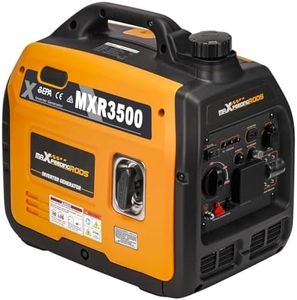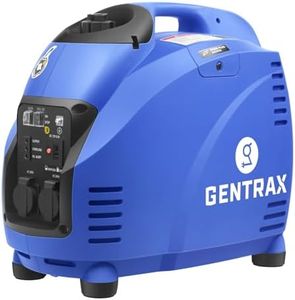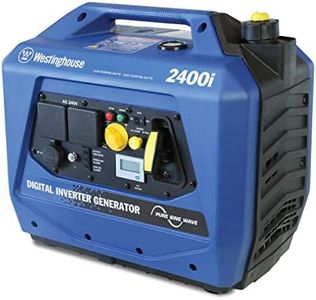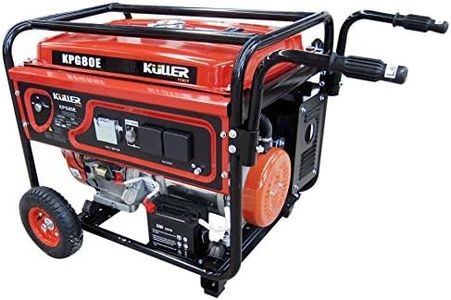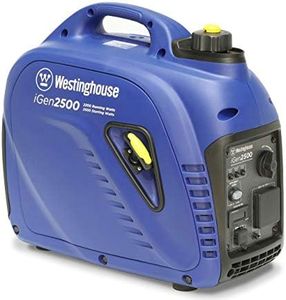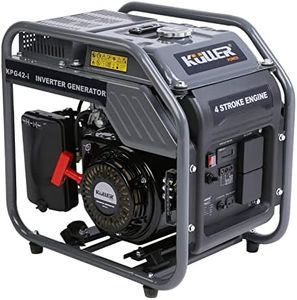We Use CookiesWe use cookies to enhance the security, performance,
functionality and for analytical and promotional activities. By continuing to browse this site you
are agreeing to our privacy policy
10 Best Gasoline Generators
From leading brands and best sellers available on the web.Buying Guide for the Best Gasoline Generators
Choosing the right gasoline generator is all about matching your power needs and usage situations with the features and capabilities of the generator. Think about where and how you'll use it—will it be for home backup during power cuts, camping, outdoor events, or job sites? Focus on reliability, power output, portability, and safety features. The goal is to find a generator that’s safe, easy to handle, provides enough electricity for what you want to run, and suits your comfort with maintenance and operation.Power Output (Wattage)Power output, usually measured in watts, tells you how much electricity the generator can deliver. This is crucial because the total wattage you need depends on the appliances and devices you plan to use at the same time. Generators come in different wattage ratings: small models (up to about 2,000W) are ideal for light use like camping or powering a few essentials; mid-range models (2,000W to 5,000W) are suitable for home backup of several appliances; and large models (above 5,000W) can run multiple large devices or tools. Make a list of what you want to run, check their wattage, and look for a generator that meets or exceeds that total.
Engine Size (cc or HP)The engine size, given in cubic centimeters (cc) or horsepower (HP), reflects the generator’s capability to generate power over time. A bigger engine usually means the generator can produce more power and run for longer periods, but it can also be heavier and noisier. Small engines are fine for occasional light use; mid-sized engines balance power and portability for typical home or outdoor use; larger engines are best for demanding jobs or running heavy loads. Pick the engine size that matches how much power you’ll use and how often you’ll need the generator.
Fuel Tank CapacityFuel tank capacity tells you how much gasoline the generator can hold, directly affecting how long it’ll run before needing a refill. Smaller tanks mean lighter weight and easier transport but shorter run times (often 3-6 hours at half load), while bigger tanks can provide extended operation (8 hours or more). If you’ll need to run the generator for long periods without interruption, especially overnight or through emergencies, look for larger tank sizes. For short-term or portable use, a smaller tank may make the generator easier to move.
Portability (Weight & Wheels)Portability covers how easily you can move the generator around, which is determined by its weight, the presence of wheels, and handles. Lightweight, compact models are great for camping or moving around the yard, while heavier models with wheels and fold-down handles are suited for larger power needs or job sites. Think about how often you’ll relocate it and whether you’ll need to transport it in a vehicle or lift it up stairs. Choose a portability setup that matches your storage and movement needs.
Noise Level (Decibels, dB)Noise level, measured in decibels (dB), indicates how loud the generator is during operation. Quiet generators (under 60 dB) are suitable for camping, outdoor gatherings, or areas with noise restrictions. Medium-range (60-70 dB) units are similar to a normal conversation, and may be just fine for many home uses. Higher noise levels (above 70 dB) are typical for large models or jobsite generators, which may not be suitable for residential areas. Choose a noise level that’s comfortable for your location and your neighbors.
Start Mechanism (Manual vs. Electric)The start mechanism is how you turn the generator on—manual (pull start) or electric (push button/start key). Manual starts are simpler and lighter but require a physical pull, which could be tough for some users. Electric starts are more convenient, often found on mid-to-large generators, and may use a battery. If you prioritize ease of use, especially for quick starts in emergencies, an electric start can be a big plus.
Outlets and ConnectionsThe number and type of outlets dictate what you can plug into the generator. Most units have a mix of standard household outlets, sometimes RV outlets, and maybe a twist-lock or 240V outlet for bigger appliances. Make sure the generator has enough of the right outlets for your intended devices—more is generally better if you have multiple things to power, but don’t forget that not all outlets can be used if you exceed the wattage. Consider your appliance plugs and check compatibility.
Run Time at Half LoadThis spec tells you how many hours the generator can run on a full tank of gas at half its maximum output. Longer run times are ideal if you need power through the night or during lengthy outages. Run time depends on engine efficiency and tank size. For continuous use, longer run times mean less need for refueling, which can be a safety and convenience advantage.
Safety Features (Low-Oil Shutoff, Surge Protection)Built-in safety features protect both the generator and your appliances. Low-oil shutoff automatically stops the engine if oil gets too low, preventing damage. Surge protection guards devices against voltage spikes. Overload protection prevents the generator from being damaged if you plug in too much. These features are especially important if you’re using the generator for sensitive electronics or want minimal maintenance worries.
